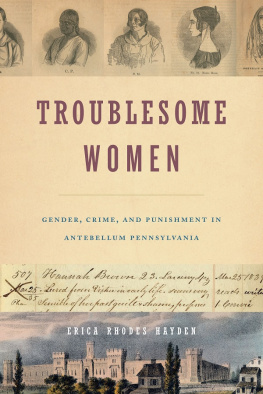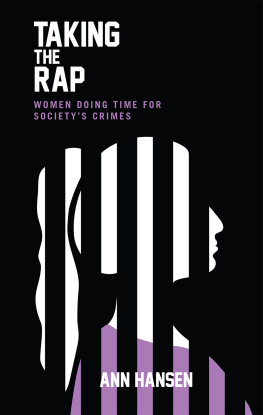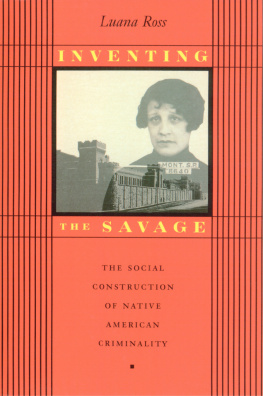BREAKING WOMEN
Breaking Women
Gender, Race, and the New Politics of Imprisonment
Jill A. McCorkel

NEW YORK UNIVERSITY PRESS
New York and London
www.nyupress.org
2013 by New York University
All rights reserved
References to Internet websites (URLs) were accurate at the time of writing. Neither the author nor New York University Press is responsible for URLs that may have expired or changed since the manuscript was prepared.
LIBRARY OF CONGRESS CATALOGING-IN-PUBLICATION DATA
McCorkel, Jill A.
Breaking women : gender, race, and the new politics of imprisonment / Jill A. McCorkel.
pages cm
Includes bibliographical references and index.
ISBN 9780814761489 (cl : alk. paper) ISBN 9780814761496 (pb : alk. paper)
1. Female offendersRehabilitationUnited States. 2. Women prisonersServices forUnited States. 3. CorrectionsUnited States. I. Title.
HV6791.M383 2013
365.6082dc23 2012050535
New York University Press books are printed on acid-free paper, and their binding materials are chosen for strength and durability. We strive to use environmentally responsible suppliers and materials to the greatest extent possible in publishing our books.
Manufactured in the United States of America
c 10 9 8 7 6 5 4 3 2 1
p 10 9 8 7 6 5 4 3 2 1
In loving memory of my grandfathers,
John C. Turnbull and Franklin Mack McCorkel
CONTENTS
PREFACE
In January 2009, then governor Arnold Schwarzenegger announced plans to close a $19.9 billion budget gap in California. His proposal to make massive cuts in social services like health care and welfare-to-work programs had all the familiar markings of the Republican Partys brand of fiscal conservatismwith one radical exception. Schwarzenegger took direct aim at prison expansion and overcrowding, promising a constitutional amendment that would prevent the state from spending more than 7% of its annual budget on corrections and plans to reduce the size of the states prison population by forty thousand persons over a period of two years. Schwarzeneggers proposal was certainly a logical one given that much of Californias budget troubles are directly linked to the states commitment to getting tough on crime by incarcerating more people, even those convicted of minor drug offenses, for long periods of time. What made it radical was that in the course of the last three decades few politicians, certainly none of Schwarzeneggers prominence, were willing to risk their political careers by offering anything less than enthusiastic support for the law and order campaign to lock em up and throw away the key. While Democrats and Republicans alike have sought to reduce government spending by gutting social welfare services, they have simultaneously (and unironically) continued to spend staggering amounts of money on prisons. Californias budget crisis is the tip of the iceberg. Across the country, states are now scrambling to find solutions to myriad problems associated with costly and overcrowded prisons.
For the first time in nearly thirty years, Americans are rethinking what it means to punish and to incarcerate. Much of the debate has focused on nonviolent drug offenders, since they represent a significant proportion of the increase in the size of the nations prison population. Proposals include sentence reductions for drug crimes, expanded use of drug treatment programs in prisons and community-based correctional settings, and granting the private prison industry an even greater role in the management and control of prisoners. As a sociologist who studies prisons, I am encouraged by efforts to rethink incarceration, but I am concerned that some of what is being proposed creates a new host of problems and exacerbates existing ones. It is this concern that prompted me to write this book now, a decade after I concluded my research study of an experimental, privately run drug treatment program in a state prison for women located in the Southeast. The program was one of the first of its kind in the country and, with an emphasis on treatment, it appeared to be moving in a decidedly different direction than the usual punitive policies. It was a program I wanted to like and, more important, one I hoped would prove successful in helping women overcome the problems that prompted their involvement in drugs and crime.
Over the course of my research, it became clear to me that the program neither helped the women it claimed to serve, nor did it provide a meaningful alternative to more traditional forms of incarceration. In many respects, its confrontational and coercive tactics effectively collapsed the distinction between treatment and punishment. This was embodied in the programs stated goal of breaking down drug offenders whom it claimed suffered from diseased selves. The program fundamentally destabilized how women understood their experiences with poverty, violence, and social marginalization, and it shattered their sense of themselves as good and respectable people. In so doing, it left most women worse off than they would have been had they simply done their time in the main prison. They returned to the same streets and neighborhoods without job skills or an education, without the confidence to pursue either of those things, and without a safety net. Not surprisingly, many resumed the same criminal hustles that landed them in prison in the first place.
Although I wrote a few scholarly articles based on this research, I hesitated in writing a book. In the politically charged climate of the nations War on Drugs, I worried that any critique of a treatment program would be read as a ringing endorsement for mass incarceration. And although I was convinced that this model of drug treatment was a failure, I wondered if what would follow in its wake would be even worse. In the years I had spent in the field, I came to know many of the women very well. I met their friends, families, husbands, boyfriends, girlfriends, baby daddies, and children. I witnessed firsthand their struggles in prison and on the streets. I learned something of what they were up against and how very high the stakes were. I did not want to write anything that would leave them and women like them any worse off. Further, even though the program and the private company that ran it became influential actors within the womens prison, I assumed that officials in the Department of Correction would cut funding if the program proved ineffective in reducing the likelihood that prisoners would resume criminal activity and drug use upon their release. As it turns out, I was wrong. The program survived and prospered even though state-sponsored studies showed that its coercive treatment practices had no effect on prisoner recidivism and relapse rates.
Today the program remains an essential component of correctional programming in the womens prison. Perhaps not coincidentally, the state now has one of the highest incarceration rates of women in the country. This program and others like it continue to gain in popularity in womens prisons and in community-based, alternative-to-incarceration programs across the country. Ultimately, I decided to write the book in order to explore the appeal of a treatment model that aims not to rehabilitate women drug offenders but to break them down. I argue that coercive therapy is not an alternative to get tough policies but a gendered extension of them. It is a failure only if we believe that its purpose is to curb crime and reduce drug use. I aim to show that there are other agendas, beyond crime control, that are at play. This program was born in the same historical moment that poor, African American women were vilified by politicians and media outlets as crack whores and welfare queens. In 1995, for example, former secretary of education William Bennett proclaimed that if you wanted to reduce crime, you could... abort every black baby.
Next page






